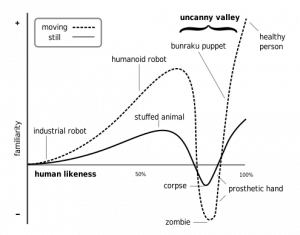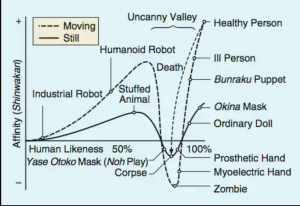Understanding the Unsettling Uncanny Valley
Written by Margaret Wei
For over 40 years, scientists have been perplexed by the phenomenon of the uncanny valley—the feeling of uneasiness and eeriness a humanoid evokes as it approaches human resemblance, but fails to do so. The concept was first introduced in 1970 in an essay that appeared in a Japanese journal called Energy written by Masahiro Mori. As a robotics professor at the Tokyo Institute of Technology, he investigated people’s reactions to robots that looked and acted almost like a human. In particular, he hypothesized that a person’s response to a humanlike robot would abruptly shift from empathy to revulsion as it approached a more lifelike appearance. The topic was not very known in the preceding years of publication, but with the rise of technology, robots, animation, and the media in recent years, the concept of the uncanny valley has gained more attention in scientific and pop culture (The uncanny…). The reason behind this response to human-like objects is still under investigation as scientists investigate which system of the body incites this feeling and its purpose.
Figure 1

A visual representation of the uncanny valley with examples. “The graph depicts the uncanny valley, the proposed relation between the human likeness of an entity, and the perceiver’s affinity for it.”
Source: Wikipedia
The Uncanny Explained
Traditionally, studies of the uncanny valley effect have focused on an object’s physical features or motion patterns to determine which characteristics present itself as unsettling. The phenomena has been framed by ideas such as pathogen avoidance, mortality salience, or the fear of psychopathic individuals, since multiple research have succeeded in uncovering such visual flaws and linking them to adverse judgments. According to these evolutionary psychology theories, aversion to human-like beings with minor flaws may function as a behavioral defense system, protecting humans from possible threats to themselves or their offspring.
At the same time, another line of study has abandoned evolutionary explanations in favor of an underlying cognitive dissonance impact as an explanation for the uncanny valley. This hypothesis is based on the idea that humans categorize a subject as “human” or “robot” using a mix of perceptual signals and previous experiences in order to predict its behavior. Observers experience cognitive dissonance when they encounter an entity that defies their expectations, which displays emotionally as unease, contempt, or terror. Notably, this line of thinking correlates to one of the first definitions of the “uncanny” word by German psychologist Ernst Anton Jentsch, who described it as an unsettling experience coming from “doubts about the animation or non-movement of things” (Stein, 2017).
Correlation Between Movement and Humanness
Another component that contributes to the eerie effect, in addition to physical appearance, is movement, which is essential to both humans and robots. Its presence alters the uncanny valley graph’s structure by increasing the heights of the peaks and valleys (Figure 2). When an industrial robot, for example, is turned off, it becomes an inanimate machine. However, after the robot’s gripper begins to move like a human hand, viewers begin to experience a sense of connection to it since it resembles human-like movement in its mannerisms. When a prosthetic hand towards the bottom of the uncanny valley begins to move, however, the sense of eeriness increases due to the presence of human-like traits while not being fully human.
Figure 2

Healthy humans at the second peak (moving), while dead bodies are unable to move, their bodies grow lifeless and cold, and their faces turn pale.
Source: The Uncanny Valley [From the Field]
Dead bodies might be viewed as a transition from the uncanny valley’s second peak (moving) to its bottom (still). This arrow heads down into the silent valley of the corpse, rather than the lively valley of the living dead, which is much to our relief. This journey reveals the mystery that lurks behind the eerie valley.
Conclusion
Why were we bestowed this strange sensation? Is it truly necessary for human survival? Many experts think it is a vital aspect of humans’ instinct for self-preservation, since the feeling of eeriness resembles a sort of instinct that shields us against proximal, rather than distal, sources of danger.
Based on the current knowledge of the psychology of the uncanny valley, future research will be aimed toward investigating how social cognition attribution interacts with particular visual traits to produce even more varied types of digital eeriness (Stein, 2017). Such research might benefit from considering the fundamental characteristics of human likeness and how they influence feelings of competence and warmth. Body components, the head, the face, proportion, symmetry, gestures, motions, and vocal inflections are examples of such traits. Certain characteristics have been linked to a higher level of human likeness than others, but more research is needed to fully comprehend and identify what exactly makes a robot human-like (Seo, 2019).
By using robotics research to generate an accurate map of the uncanny valley, we can better understand not only what makes humans human, but also how to design nonhuman technologies that people can connect to.
References and Sources
Cheetham, M., Suter, P., & Jancke, L. (1AD, January 1). Perceptual discrimination difficulty and familiarity in the Uncanny Valley: More like a “happy valley”. Frontiers. Retrieved February 23, 2022, from https://www.frontiersin.org/articles/10.3389/fpsyg.2014.01219/full
Ferrey, A. E., Burleigh, T. J., & Fenske, M. J. (1AD, January 1). Stimulus-category competition, inhibition, and affective devaluation: A novel account of the uncanny valley. Frontiers. Retrieved February 23, 2022, from https://www.frontiersin.org/articles/10.3389/fpsyg.2015.00249/full
Seo, Y. K., Schmitt, B. H., & Thalmann, N. M. (2019). Eliza in the uncanny valley: Anthropomorphizing consumer robots increases their perceived warmth but decreases liking. Marketing Letters, 30(1), 1-12. doi:http://dx.doi.org/10.1007/s11002-019-09485-9
Stein, J.P., Ohler P, Venturing into the uncanny valley of mind—The influence of mind attribution on the acceptance of human-like characters in a virtual reality setting, Cognition, Volume 160, 2017, Pages 43-50, https://doi.org/10.1016/j.cognition.2016.12.010. https://www.sciencedirect.com/science/article/pii/S0010027716303055
The uncanny valley [from the field]. IEEE Xplore. (n.d.). Retrieved February 23, 2022, from https://ieeexplore.ieee.org/document/6213238
Tian, L. (2019, April 10). The uncanny valley: A possible explanation for creepiness. Medium. Retrieved February 23, 2022, from https://medium.com/@lutian_71494/the-uncanny-valley-a-possible-explanation-for-creepiness-5ce7361d777e